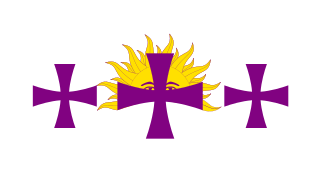
Hispanidad is a Spanish term alluding to the group of people, countries, and communities that share the Spanish language and Hispanic culture. The term can have various, different implications and meanings depending on country of origin, socio-political views, and cultural background.

The Pachón Navarro is a Spanish breed of hunting dog from the autonomous community of Navarre, in northern Spain. It is one of five Basque breeds of dog, the others being the Basque Shepherd Dog, the Erbi Txakur, the Villano de Las Encartaciones and the Villanuco de Las Encartaciones.

The Chief of Staff of the Navy or Admiral Chief of Staff of the Navy (AJEMA) is the highest-ranking military officer of the Spanish Navy that, under the authority of the Defence Minister, exercises command over the naval branch and, as such, is the principal military advisor to the Chief of the Defence Staff, the Minister of Defence, the Secretary of State for Defence, the Under-Secretary of Defence and the National Defence Council.

Jaime Lissavetzky Díez is a Spanish chemist and politician. Secretary of State for Sport (2004–2011) and regional minister of Education of the Government of the Community of Madrid. He was member of the 1st, 2nd, 3rd, 4th and 5th terms of the Assembly of Madrid, as well as member of the 8th Congress of Deputies and city councillor in the Ayuntamiento of Madrid.

José Teófilo Serrano Beltrán is a Spanish politician, civil servant and engineer, member of the Spanish Socialist Workers' Party (PSOE).
Francisco Gómez de Llano (1896–1970) was a Spanish politician and diplomat. In Francoist Spain, he served as Minister of Finance (1951–1957) and as Ambassador to the Holy See (1957–1962).

Eduardo González Calleja is a Spanish historian, professor of Contemporary History at the Charles III University of Madrid (UC3M). He is the author of a long list of scholar works dealing with political violence.

The first government of José Luis Rodríguez Zapatero was formed on 18 April 2004, following the latter's election as Prime Minister of Spain by the Congress of Deputies on 16 April and his swearing-in on 17 April, as a result of the Spanish Socialist Workers' Party (PSOE) emerging as the largest parliamentary force at the 2004 Spanish general election. It succeeded the second Aznar government and was the Government of Spain from 18 April 2004 to 14 April 2008, a total of 1,457 days, or 3 years, 11 months and 27 days.

The second government of José Luis Rodríguez Zapatero was formed on 14 April 2008, following the latter's election as Prime Minister of Spain by the Congress of Deputies on 11 April and his swearing-in on 12 April, as a result of the Spanish Socialist Workers' Party (PSOE) emerging as the largest parliamentary force at the 2008 Spanish general election. It succeeded the first Zapatero government and was the Government of Spain from 14 April 2008 to 22 December 2011, a total of 1,347 days, or 3 years, 8 months and 8 days.

The third government of Felipe González was formed on 7 December 1989, following the latter's election as Prime Minister of Spain by the Congress of Deputies on 5 December and his swearing-in on 6 December, as a result of the Spanish Socialist Workers' Party (PSOE) emerging as the largest parliamentary force at the 1989 Spanish general election. It succeeded the second González government and was the Government of Spain from 7 December 1989 to 14 July 1993, a total of 1,315 days, or 3 years, 7 months and 7 days.

The fourth government of Felipe González was formed on 14 July 1993, following the latter's election as Prime Minister of Spain by the Congress of Deputies on 9 July and his swearing-in on 13 July, as a result of the Spanish Socialist Workers' Party (PSOE) emerging as the largest parliamentary force at the 1993 Spanish general election. It succeeded the third González government and was the Government of Spain from 14 July 1993 to 6 May 1996, a total of 1,027 days, or 2 years, 9 months and 22 days.

Anti-American sentiment is perceived to be deeply entrenched within elements of Spanish society, with several surveys conducted concerning the topic tending to back up that assertion. Spain ranks among the highest countries in terms of the level of anti-Americanism in Europe. According to a German Marshall Fund study, feelings towards the United States in Spain were among the least favourable in Europe, second only to Turkey. The sentiment has been historically far from being only a left-wing nature but, the United States is view very negatively by right-wing factions in Spain.

The fourth government of Francisco Franco was formed on 19 July 1951. It succeeded the third Franco government and was the Government of Spain from 19 July 1951 to 25 February 1957, a total of 2,048 days, or 5 years, 7 months and 6 days.

The third government of Francisco Franco was formed on 20 July 1945, following the end of World War II in Europe. It succeeded the second Franco government and was the Government of Spain from 20 July 1945 to 19 July 1951, a total of 2,190 days, or 5 years, 11 months and 29 days.

The second government of Francisco Franco was formed on 9 August 1939, following the end of the Spanish Civil War. It succeeded the first Franco government and was the Government of Spain from 9 August 1939 to 20 July 1945, a total of 2,172 days, or 5 years, 11 months and 11 days.

The first government of Francisco Franco was formed on 31 January 1938 during the Spanish Civil War, shortly after having been proclaimed as Head of State of Spain. It succeeded the Technical State Junta in the Nationalist zone—eventually, it would also take over from the Republican National Defence Council at the end of the war—and was the Government of Spain from 31 January 1938 to 9 August 1939, a total of 555 days, or 1 year, 6 months and 9 days.














